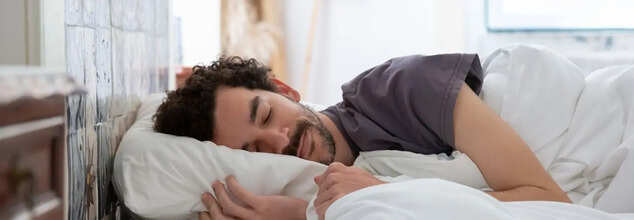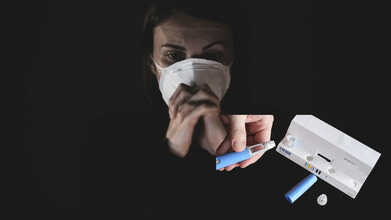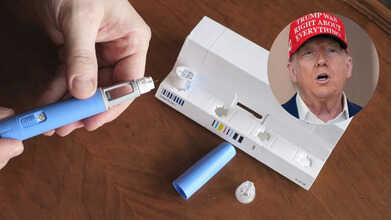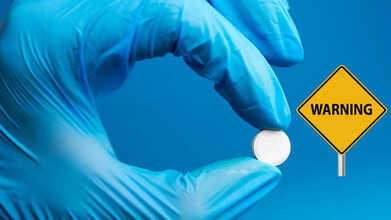- Health Conditions A-Z
- Health & Wellness
- Nutrition
- Fitness
- Health News
- Ayurveda
- Videos
- Medicine A-Z
- Parenting
- Web Stories
Why Do You Sleep More In Winters? It Has Everything To Do With Your Hormones

Sleep In Winters ( Credit: Canva)
There is a scientific reason behind why humans tend to sleep more during winters and it is related to your hormones. Many people notice they feel more fatigued in winter, even though their overall sleep needs remain consistent throughout the year.
Sleep needs for most adults range from seven to nine hours per night, regardless of the season. However, it is common to feel like you’re sleeping more in winter due to the earlier onset of darkness during standard time.
Seasonal Sleep Changes
Recent studies indicate that humans, like some animals, experience subtle seasonal variations in sleep. Research conducted in Berlin found participants slept about an hour longer in winter than in summer, with 30 additional minutes of rapid eye movement (REM) sleep during the colder months. To note, REM sleep is crucial for memory, mood regulation, and immune function.
How Light Affects Sleep
Our sleep-wake cycle or the circadian rhythm is closely tied to sunlight. Bright light signals the body to stay awake, while darkness prompts melatonin production, a hormone that helps regulate sleep. During winter, shorter days and longer nights lead to earlier melatonin release, which may make you feel sleepier earlier in the evening. The same goes for the morning, late sunrise makes you sleep more.
However, social habits, like late-night outings during summer, can disrupt this rhythm. As per a clinical psychologist specializing in sleep, the body may struggle to adjust to sleeping earlier during winter nights, leading to delayed sleep onset or increased sleepiness.
Environmental Changes
The challenge to stay awake for longer hours extends beyond the biological changes that your body goes through. Winter season is the holiday season with celebrations such as Thanksgiving, Christmas and New Year's. Holiday stress, indulgent eating, alcohol consumption, and skipping workouts can also affect sleep. These behaviours, combined with seasonal affective disorder (SAD), may further increase the desire for sleep.Adapting To Winter Sleep Patterns
While humans do not hibernate, minor adjustments can help manage winter sleepiness. Experts recommend:- Morning Light Exposure: Natural sunlight or light therapy using a light box can regulate your circadian rhythm and alleviate symptoms of SAD.
- Consistent Sleep Schedule: Maintaining regular sleep and wake times helps stabilize your internal clock.
- Creating a Sleep-Friendly Environment: A dark, quiet, and cool bedroom promotes restful sleep.
Additionally, workplaces and schools could consider later start times during winter to align with natural light patterns, enhancing alertness and productivity.
When Should You See A Doctor?
If seasonal sleep changes lead to depression or difficulty functioning, consult a healthcare professional. According to health experts, seeking support for seasonal depression is important for maintaining overall health and well-being.
While winter's shorter days can make you feel sleepier, understanding the role of light and adjusting your habits can help you navigate the season effectively. Embrace these changes, but don’t hesitate to seek help if you find yourself struggling with sleep or mood disruptions.
Can GLP-1 Weight Loss Drugs Help Long COVID Patients Recover?

Credits: Canva
Fatigue, joint pain, headaches, and cognitive issues often described as “brain fog” are among the lingering effects many people experience long after recovering from COVID-19. This condition, known as long COVID, can persist for months or even years—and so far, there’s no proven treatment. But researchers are now exploring an unexpected source of hope: a diabetes and obesity drug called tirzepatide.
What Is Tirzepatide?
Tirzepatide is a prescription injectable medication primarily used to manage type 2 diabetes and support chronic weight management in adults who are obese or overweight with a related condition. It is sold under two brand names: Mounjaro, used for diabetes, and Zepbound, approved for weight loss.
Can Weight Loss Drugs Help Long COVID Patients Recover?
In a recent survey led by Dr. Julia Moore Vogel, a program director at Scripps Research, patients with long COVID who were prescribed tirzepatide reported striking results. Between 60% and 90% of participants said their symptoms improved.
“I was expecting only about 30% to show improvement,” Vogel said. “If it’s truly between 60% and 90%, that would be remarkable.”
Encouraged by these early findings, Vogel and her team have launched a clinical trial at Scripps Research to test the drug’s potential benefits more rigorously. The trial, currently a quarter of the way through recruitment, aims to enroll 1,000 participants with long COVID. Half will receive tirzepatide, while the other half will take a placebo.
A Drug with Far-Reaching Effects
Tirzepatide, developed by Eli Lilly, belongs to a class of drugs known as GLP-1 receptor agonists, already popular for their effectiveness in treating obesity and type 2 diabetes. According to Dr. Eric Topol, co-director of the Scripps clinical trial and founder of the Scripps Research Translational Institute, this class of medications could have much broader applications.
“When I say potent, I mean across multiple systems,” Topol explained. “Not just weight loss, but also benefits for the heart, liver, kidneys, migraine headaches, even rheumatoid arthritis and addiction.”
Eli Lilly is supplying the drug for the study, while the project is being funded by the Schmidt Institute for Long COVID (SILC).
A First-of-Its-Kind Virtual Trial
According to Dr. John Redd, CEO of SILC, the Scripps study is breaking new ground with its fully remote trial design.“This is the first long COVID clinical trial that allows patients to participate entirely from home,” Redd said. “Medication is shipped directly to participants, and all assessments are conducted virtually. It opens the door for patients across the U.S. to take part.”
Off-Label Use and Access Challenges
While tirzepatide is already FDA-approved for diabetes and weight loss, its use for long COVID remains experimental. Vogel noted that “off-label” use of approved drugs is common in medicine, but coverage barriers can limit access.
“The challenge for many patients will be insurance,” she explained. “Companies will likely require stronger data before agreeing to cover such an expensive medication.”
A Researcher with Personal Stakes
For Vogel, this research is deeply personal. She has lived with long COVID for five years, an experience that has left her largely homebound, as per KPBS News,
“No treatment I’ve tried has helped,” she shared. “When I saw that 60 to 90 percent of people reported improvement on tirzepatide, I was blown away. I really hope the data confirms it.”
The Scripps team is also studying body-monitor data to track how patients’ symptoms change over time, hoping to gain clearer insights into how and why tirzepatide might work.
Though it’s still early, the findings have offered a glimmer of optimism for millions struggling with the long-term effects of COVID-19. If tirzepatide’s promise holds true, it could mark a significant step toward understanding and treating one of the pandemic’s most stubborn mysteries.
TrumpRx To Offer Cheaper Weight Loss Drugs; Experts Say Not Everyone Will Benefit — Here’s Why

Credits: Canva
President Donald Trump unveiled a plan to reduce the cost of popular weight loss drugs, including Wegovy and Zepbound, through his self-pay platform, TrumpRx. The move aims to make these medications more accessible to Americans paying out of pocket.
However, drug policy experts warn that the plan may not benefit everyone. Juliette Cubanski, deputy director of the Medicare policy program at KFF, said, “It’s a situation where we have more questions than answers…there’s a lot that the administration itself hasn’t even ironed out as of yet.”
What is TrumpRx?
TrumpRx is a self-pay online platform launched by the Trump administration to sell prescription medications, including popular weight loss drugs, at discounted prices. It is designed for patients who pay out of pocket, aiming to make high-cost treatments like Wegovy and Zepbound more affordable, as per USA Today.
TrumpRx Launches Discounted Weight Loss Medications
President Donald Trump unveiled a plan to reduce the cost of popular weight loss drugs, including Wegovy and Zepbound, through his platform, TrumpRx. The move aims to make these medications more accessible to Americans paying out of pocket.
However, drug policy experts warn that the plan may not benefit everyone. Juliette Cubanski, deputy director of the Medicare policy program at KFF, said, “It’s a situation where we have more questions than answers…there’s a lot that the administration itself hasn’t even ironed out as of yet.”
TrumpRx Zepbound Price Drop: Starting Doses Only
The White House confirmed that the starting doses of GLP-1 pills like Zepbound will cost $149 a month, while injections will have an initial “weighted average” price of $350, expected to drop to $250 within two years.
Experts note this may not reflect real costs. Art Caplan, head of medical ethics at NYU Grossman School of Medicine, explained, as per NBC News, “You can’t really tell from what’s going on…It’s just murky as to how this will take shape, how the programs will work.”
Patients often increase doses over time for effective weight loss, meaning those relying on higher doses may pay significantly more than the starting prices advertised.
TrumpRx and Medicare Coverage: Limited Access
Under the deal, Medicare will pay $245 a month for Zepbound injections, and patients’ copays will be capped at $50. Medicaid enrollees often have no copay.
But Cubanski warns, “Medicare, by law, is barred from covering weight loss drugs alone,” meaning only patients with additional conditions like heart or kidney disease will qualify. Stacie Dusetzina, a health policy professor at Vanderbilt University, said as per NBC News, “Without broader coverage, millions of patients will remain priced out even as the administration touts lower costs.”
TrumpRx: Unapproved Versions Included
The plan also covers drug forms that have not yet received FDA approval, including oral versions and multidose Zepbound pens. Lawrence Gostin, director of the O’Neill Institute at Georgetown University, described this as risky: “It is reckless to negotiate pricing deals on products which the FDA have not yet approved as safe and effective. The administration is getting way out ahead of its own safety agency.”
TrumpRx Savings: Experts Urge Caution
While the deal may seem ambitious, experts caution that actual savings for patients could be limited. Cubanski emphasized, “It just feels a little bit too squishy right now.” Dr Shauna Levy, an obesity specialist, added, “As an obesity community, I think we will remain skeptical of this deal until we see how it actually plays out.”
Limitations in coverage, unapproved drug versions, and higher costs for increased doses mean the impact may be less than anticipated. Patients and healthcare providers will need to carefully navigate these changes, weighing potential savings against practical access and safety considerations.
NHS Issues New Warning On Tramadol, Long-Term Use May Trigger THIS Health Condition

Credits: Canva
Tramadol, part of the opioid class, is commonly prescribed for moderate to severe pain, such as after an injury or surgery. Because of its potency and ability to manage pain effectively, doctors may turn to tramadol when other pain relievers fail. It is usually available as a tablet or capsule, but can also be given as a liquid or injection, the latter often used in hospital settings.
In certain cases, ongoing tramadol use may be necessary, especially for those living with chronic pain conditions. While it can be essential for daily pain management, it is important to be aware that prolonged use may increase the risk of unwanted side effects.
What is Tramadol?
Tramadol is a dual-action opioid that affects serotonin and norepinephrine pathways, often described as a middle-ground painkiller, stronger than non-opioid medications but thought to be less addictive than morphine. It is prescribed for moderate-to-severe pain, including both post-surgical discomfort and long-term chronic conditions.
Globally, prescriptions have surged, partly because of the perception that tramadol is safer and carries a lower risk of dependence compared with stronger opioids.
Tramadol Side Effects: Dangers of Taking Tramadol Over A Long-Term Period
Hyperalgesia
The NHS has warned about the risks of long-term tramadol use, including hyperalgesia. This condition can make you more sensitive to pain, so that ordinary aches feel much stronger or more intense than usual. If this occurs, your doctor may recommend gradually reducing the tramadol dose to help ease these heightened sensations.
Tolerance
Over time, the body can develop a tolerance to tramadol. This means you may need higher doses to achieve the same level of pain relief that you once got from a smaller amount.
Addiction
Being an opioid, tramadol carries a risk of addiction, particularly when used for a long stretch. Signs that dependency is developing could include difficulty stopping the medication or taking it more often than prescribed.
Stopping tramadol suddenly can also lead to withdrawal symptoms, such as feelings of anxiety or restlessness. If this happens, your GP may reassess your treatment plan to ensure you are on the safest dose necessary to manage your pain effectively.
Time To Reconsider Tramadol For Chronic Pain?
Recent research, including a systematic review and meta-analysis by Medscape, suggests that tramadol’s effectiveness for chronic pain may be limited. The studies found only minimal pain relief while noting that serious side effects were twice as likely among tramadol users, particularly cardiac complications.
“Considering the modest pain relief and heightened risk of harm, tramadol should be reconsidered for chronic pain management,” said Dr. Jehad Ahmad Barakji of the Centre for Clinical Intervention Research at Rigshospitalet in Copenhagen, speaking to Medscape Medical News.
Researchers did note that the quality of evidence varied, with certainty ranging from low to moderate. Common serious issues involved the heart, such as chest pain, coronary artery disease, and heart failure. Non-serious but bothersome side effects — including nausea, dizziness, constipation, and drowsiness, were frequent and often led patients to stop taking the drug.
This article is for informational purposes only and is not a substitute for professional medical advice. Always consult your doctor or a qualified healthcare professional regarding any questions about medications or health conditions.
© 2024 Bennett, Coleman & Company Limited

